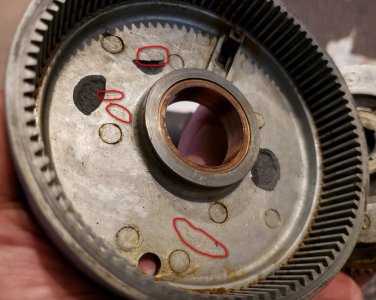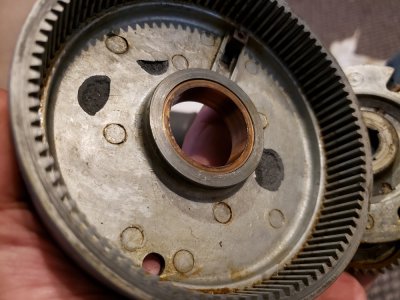Hello; I recently inherited this little Craftsman 109. Took the headstock apart, it has this planetary gear arrangement. In the pic, you can see some spalling on the inside - those dark spots - where the metal seems to have flaked out. Little bits of metal were all in the gear teeth. If this ran at all, I'm sure it made a crazy racket. The gears themselves look OK, and after cleaning they turn freely. So the question is what to do now... I was thinking of skim coating the inside of that housing with JB Weld. Or cut a disc of sheet metal and JB Weld it to the surface. Or am I overthinking it? Anyone seen this before? Thanks for reading...
-
Welcome back Guest! Did you know you can mentor other members here at H-M? If not, please check out our Relaunch of Hobby Machinist Mentoring Program!
You are using an out of date browser. It may not display this or other websites correctly.
You should upgrade or use an alternative browser.
You should upgrade or use an alternative browser.
How to repair Craftsman 6" lathe, planetary.
- Thread starter mbseto
- Start date
- Joined
- Jan 2, 2014
- Messages
- 8,852
My guess is zinc-pest.
References here:
https://en.wikipedia.org/wiki/Zinc_pest
https://dfarq.homeip.net/zinc-pest-what-it-is-and-what-to-do-about-it/
It is new crystal growth within the alloy caused by lead (Pb) impurities.
....and unfortunately, if it is, that entire assembly is compromised.
Now, these might just be surface scratches..........get it under some good light and good magnification:

If it is zinc-pest then you'll see a bunch more cracks and even finger pressure might make it crumble in your hands....
I came across an example of it recently when I cleaned out my bedroom closet. All the metal clasps on my luggage disintegrated when I touched them. I have the parts set aside so I could do a show-and-tell here, but have not taken the pictures yet. I want to set-up my microscope camera too.
-brino
References here:
https://en.wikipedia.org/wiki/Zinc_pest
https://dfarq.homeip.net/zinc-pest-what-it-is-and-what-to-do-about-it/
It is new crystal growth within the alloy caused by lead (Pb) impurities.
....and unfortunately, if it is, that entire assembly is compromised.
Now, these might just be surface scratches..........get it under some good light and good magnification:

If it is zinc-pest then you'll see a bunch more cracks and even finger pressure might make it crumble in your hands....
I came across an example of it recently when I cleaned out my bedroom closet. All the metal clasps on my luggage disintegrated when I touched them. I have the parts set aside so I could do a show-and-tell here, but have not taken the pictures yet. I want to set-up my microscope camera too.
-brino
Last edited:
- Joined
- Feb 1, 2015
- Messages
- 9,605
Good detective work @brino. Not a lot published on the cause but I would guess it involves oxidation of the zinc when in contact with humidity and oxygen. There is probably a nonuniform distribution of the alloying metals in the casting and in combination with moisture and air, they create an electrolytic couple. Once the zinc has oxidized, it would form a weak electrolyte which would hasten the destruction.
From the photo, it appear that you still have enough material left for the gear to function. Prevention of contact with moisture and air should reduce further deterioration. I would remove the gear and inspect the back side for wear. Then I would clean the gear thoroughly using a fine wire brush. A vinegar or oxalic acid solution was recommended to remove oxidized zinc. Next, I would rinse the part thoroughly with a final rinse with acetone . Follow that with a coating of epoxy on all non-contact areas. You can then build up with JB Weld on areas with severe degradation if you wish. For areas where you have contact with other parts frequent lubrication should exclude moisture and air.
From the photo, it appear that you still have enough material left for the gear to function. Prevention of contact with moisture and air should reduce further deterioration. I would remove the gear and inspect the back side for wear. Then I would clean the gear thoroughly using a fine wire brush. A vinegar or oxalic acid solution was recommended to remove oxidized zinc. Next, I would rinse the part thoroughly with a final rinse with acetone . Follow that with a coating of epoxy on all non-contact areas. You can then build up with JB Weld on areas with severe degradation if you wish. For areas where you have contact with other parts frequent lubrication should exclude moisture and air.
- Joined
- Feb 13, 2017
- Messages
- 2,138
@brino about nails it. I have run into "zinc pest" many times on my models. Fortunately, the Craftsman 12X36 does not show any signs of it. It is a common malady of ZAMAK castings. I personally do not know of any way to repair it. Some say it can be coated if found early enough. All I know is that "chlorinated" solvents ("BrakeKleen" being one) are deadly, causing disintegration in short order. Most of the chips showing in the photos seem to me to be benign. However, there are a couple of cracks in the casting that are debatable. Tapping with a nonmetallic hammer will either cause breakoffs or not. If a piece breaks off, the casting is done. If nothing happens, coating should work to protect it for a while. Short of making replacement parts from aluminium, I don't know of any solution. Which would be difficult for the ring gear. . .
.
.
OK guys, thanks for the input. I got a nylon hammer and rapped this thing as hard as I dared, inside and out. No additional flaking, and it sounded fairly solid. I'm hoping maybe this was just a small bit of surface contamination in the casting. I'm going to proceed with the JB Weld idea. I'll post some progress pics afterwards. Thanks again, all.
- Joined
- Jun 29, 2014
- Messages
- 4,059
There are two problems you can encounter with zinc alloy die castings...
Zinc pest and white stain. While both can affect zinc based products they have different causes and effects.
As previously stated zinc pest or zinc rot is based on impurities in the alloy. Lead is the culprit and causes brittleness/disintegration. There is no remedy for this.
White stain or white rust is a form of corrosion but is due to lack of oxygen and a presence of CO2. This could be your problem here.
In the end, Bill is right, if the casting isn’t crumbling under some duress, it’s fine to use. I’m not even sure the skim coat is necessary but if that satisfies you then it is worth the effort now in the moment.
Sent from my iPhone using Tapatalk
Zinc pest and white stain. While both can affect zinc based products they have different causes and effects.
As previously stated zinc pest or zinc rot is based on impurities in the alloy. Lead is the culprit and causes brittleness/disintegration. There is no remedy for this.
White stain or white rust is a form of corrosion but is due to lack of oxygen and a presence of CO2. This could be your problem here.
In the end, Bill is right, if the casting isn’t crumbling under some duress, it’s fine to use. I’m not even sure the skim coat is necessary but if that satisfies you then it is worth the effort now in the moment.
Sent from my iPhone using Tapatalk
- Joined
- Jul 13, 2017
- Messages
- 636
Any chance chrome plating would stop the advance of zinc pest?
The geared headstock of my Maximat V10p lathe has zamac forks which are known to fall apart and damage the micarta gears.
The geared headstock of my Maximat V10p lathe has zamac forks which are known to fall apart and damage the micarta gears.
- Joined
- Jun 29, 2014
- Messages
- 4,059
No. Zinc pest is a crystalline formation problem due to impurities in the alloy. Zinc pest is like osteoporosis. Brittle bones. Chrome plating will only affect the outer layer of the part and it doesn't change the properties of the Pb impurities and the alloy.Any chance chrome plating would stop the advance of zinc pest?
The geared headstock of my Maximat V10p lathe has zamac forks which are known to fall apart and damage the micarta gears.
It is possible that if it is white rust, different then zinc pest - then a plating would arrest the corrosion. Keep in mind though, that zinc alloys form their own passive oxidation layer due to some aluminum content and the nature of the alloy. White rust occurs when, for example, you stack parts on each other right after die casting and that oxygen can't readily access the surface and form the oxidized layer for protection.


